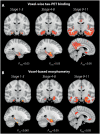Early stages of tau pathology and its associations with functional connectivity, atrophy and memory
- PMID: 33725124
- PMCID: PMC8557349
- DOI: 10.1093/brain/awab114
Early stages of tau pathology and its associations with functional connectivity, atrophy and memory
Abstract
In Alzheimer's disease, post-mortem studies have shown that the first cortical site where neurofibrillary tangles appear is the transentorhinal region, a subregion within the medial temporal lobe that largely overlaps with Brodmann area 35, and the entorhinal cortex. Here we used tau-PET imaging to investigate the sequence of tau pathology progression within the human medial temporal lobe and across regions in the posterior-medial system. Our objective was to study how medial temporal tau is related to functional connectivity, regional atrophy, and memory performance. We included 215 amyloid-β- cognitively unimpaired, 81 amyloid-β+ cognitively unimpaired and 87 amyloid-β+ individuals with mild cognitive impairment, who each underwent 18F-RO948 tau and 18F-flutemetamol amyloid PET imaging, structural T1-MRI and memory assessments as part of the Swedish BioFINDER-2 study. First, event-based modelling revealed that the entorhinal cortex and Brodmann area 35 show the earliest signs of tau accumulation followed by the anterior and posterior hippocampus, Brodmann area 36 and the parahippocampal cortex. In later stages, tau accumulation became abnormal in neocortical temporal and finally parietal brain regions. Second, in cognitively unimpaired individuals, increased tau load was related to local atrophy in the entorhinal cortex, Brodmann area 35 and the anterior hippocampus and tau load in several anterior medial temporal lobe subregions was associated with distant atrophy of the posterior hippocampus. Tau load, but not atrophy, in these regions was associated with lower memory performance. Further, tau-related reductions in functional connectivity in critical networks between the medial temporal lobe and regions in the posterior-medial system were associated with this early memory impairment. Finally, in patients with mild cognitive impairment, the association of tau load in the hippocampus with memory performance was partially mediated by posterior hippocampal atrophy. In summary, our findings highlight the progression of tau pathology across medial temporal lobe subregions and its disease stage-specific association with memory performance. While tau pathology might affect memory performance in cognitively unimpaired individuals via reduced functional connectivity in critical medial temporal lobe-cortical networks, memory impairment in mild cognitively impaired patients is associated with posterior hippocampal atrophy.
Keywords: Alzheimer’s disease; MRI; medial temporal lobe subregions; memory; tau-PET imaging.
© The Author(s) (2021). Published by Oxford University Press on behalf of the Guarantors of Brain.
Figures





References
Publication types
MeSH terms
Substances
Grants and funding
LinkOut - more resources
Full Text Sources
Other Literature Sources
Medical

